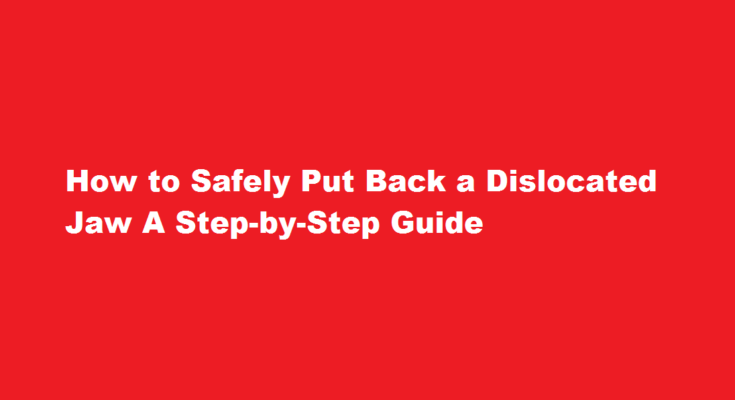Introduction
A dislocated jaw can be a painful and distressing experience, resulting from trauma or excessive jaw movement. While a dislocated jaw requires immediate medical attention, knowing how to handle the situation safely before professional help arrives can make a significant difference in preventing further injury and alleviating discomfort. This article provides a unique and informative guide on how to put back a dislocated jaw properly, highlighting the importance of seeking medical assistance while offering essential steps to stabilize the jaw in the meantime.
Understanding Dislocated Jaws
A dislocated jaw occurs when the mandible bone, also known as the lower jaw, becomes displaced from its normal position in the temporomandibular joint (TMJ). Common causes include accidents, falls, blows to the face, and extreme jaw movements, such as yawning or biting on something hard. Symptoms of a dislocated jaw may include severe pain, inability to close the mouth, difficulty speaking, and visible misalignment of the jaw.
Immediate Actions
- Stay Calm If you or someone else experiences a dislocated jaw, it is essential to remain calm. Panic can exacerbate the situation, leading to additional muscle tension and making the relocation process more difficult.
- Do Not Force the Jaw Attempting to force the jaw back into place without proper knowledge and training can result in further injury or complications. Avoid any manipulation unless you are a trained medical professional.
- Support the Jaw Gently support the lower jaw with your hands to prevent unnecessary movement. Encourage the person not to try to close their mouth or move their jaw until professional medical help arrives.
Seeking Medical Assistance
Putting back a dislocated jaw should be performed by a healthcare professional, such as a dentist, oral surgeon, or emergency room physician. If available, call emergency services or visit the nearest hospital immediately. While waiting for medical assistance, follow these steps to stabilize the jaw safely
Stabilizing the Jaw
- Create a Make-Shift Sling If a dislocated jaw is suspected, provide support to the jaw to minimize movement. Gently wrap a cloth or a scarf under the chin and tie it securely on top of the head. This makeshift sling will help keep the jaw in place.
- Apply Cold Compress To reduce pain and swelling, apply a cold compress or an ice pack wrapped in a cloth to the affected area for 15-20 minutes every hour. Avoid placing the ice directly on the skin.
- Pain Management Over-the-counter pain relievers, such as ibuprofen or acetaminophen, can help manage pain temporarily. Follow the recommended dosage and guidelines.
- Soft Diet Encourage the person to stick to a soft or liquid diet to prevent further strain on the jaw. Avoid hard, chewy, or crunchy foods until medical attention is received.
Professional Relocation
Once the individual reaches a healthcare facility, a medical professional will perform the relocation procedure. This typically involves the following steps
- Assessment The healthcare provider will assess the patient’s condition, possibly using X-rays or other imaging techniques to evaluate the extent of the dislocation.
- Muscle Relaxation To facilitate the relocation, the medical professional may administer muscle relaxants or sedatives to ease muscle tension and promote relaxation.
- Controlled Manipulation With the patient under the effects of the muscle relaxant, the healthcare provider will use precise and controlled movements to guide the jaw back into its proper position within the TMJ.
- Post-relocation Care After successful relocation, the patient will receive instructions on post-relocation care, including pain management, diet restrictions, and the use of warm compresses to ease soreness.
Frequently Asked Questions
How do you put a dislocated jaw back in place?
After wrapping their fingers with gauze, doctors or dentists place their thumbs inside the mouth on the lower back teeth. They place their other fingers around the bottom of the lower jaw. They press down on the back teeth and push the chin up until the jaw joints return to their normal location.
What is the healing process for a dislocated jaw?
Recovery from a jaw fracture or dislocation requires patience. You won’t be able to open your jaw very wide or at all for at least six weeks during treatment. Your doctor will prescribe painkillers and antibiotics to prevent infection.
Conclusion
Dealing with a dislocated jaw can be a daunting experience, but knowing how to respond calmly and safely is crucial in providing temporary relief before professional medical assistance is obtained. Remember, putting back a dislocated jaw should only be attempted by trained healthcare professionals. Stabilizing the jaw through a makeshift sling and applying cold compresses can help alleviate pain and minimize movement until medical help arrives. Prompt treatment by a qualified healthcare provider ensures a successful and safe relocation, reducing the risk of complications and promoting a faster recovery.
Read Also : Realigning The Dislocated Knee A Comprehensive Guide to First Aid and Recovery



